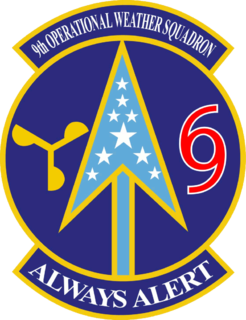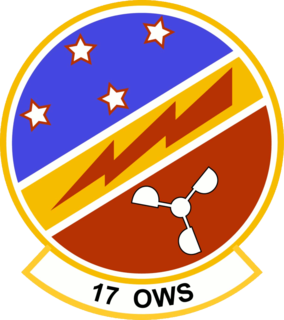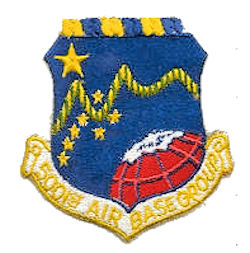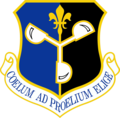
Eielson Air Force Base is a United States Air Force (USAF) base located approximately 26 miles (42 km) southeast of Fairbanks, Alaska and just southeast of Moose Creek, Alaska. It was established in 1943 as Mile 26 Satellite Field and redesignated Eielson Air Force Base on 13 January 1948. It has been a Superfund site since 1989. Eielson AFB was named in honor of polar pilot Carl Ben Eielson.

The Eleventh Air Force (11 AF) is a Numbered Air Force of the United States Air Force Pacific Air Forces (PACAF). It is headquartered at Joint Base Elmendorf–Richardson, Alaska.

Alaskan Air Command (AAC) is an inactive United States Air Force Major Command originally established in 1942 under the United States Army Air Forces. Its mission was to organize and administer the air defense system of Alaska, exercise direct control of all active measures, and coordinate all passive means of air defense. In addition, the command also supported Strategic Air Command elements operating through and around Alaska. It was redesignated Eleventh Air Force on 9 August 1990 and, concurrently, status changed from a major command of the United States Air Force to a subordinate organization of Pacific Air Forces.

Ladd Army Airfield is the military airfield located at Fort Wainwright in Fairbanks, Alaska. It was originally called Fairbanks Air Base, but was renamed Ladd Field on 1 December 1939, in honor of Major Arthur K. Ladd, a pilot in the U.S. Army Air Corps who died in a plane crash near Dale, South Carolina on 13 December 1935.

The 343d Wing is an inactive United States Air Force unit. Its last assignment was with Pacific Air Forces at Eielson Air Force Base, Alaska, where it was inactivated on 20 August 1993. The unit was formed at Eielson as the 343d Composite Wing and activated in October 1981 to replace the 5010th Combat Support Group. It operated both fighter and forward air control aircraft. In 1991, it also became the administrator for periodic Exercise Cope Thunder operations, which moved to Alaska from the Philippines after the eruption of Mount Pinatubo resulted in the evacuation of units from Clark Air Base When the wing was inactivated, it was replaced at Eielson by the 354th Fighter Wing.

The 18th Aggressor Squadron is a subordinate unit of the 354th Fighter Wing based at Eielson Air Force Base in Alaska, and flies the Block 30 General Dynamics F-16C/D aircraft.

The 611th Air Operations Center is an active unit of the United States Air Force's Eleventh Air Force. Based at Joint Base Elmendorf–Richardson, Alaska, it was activated in 1994.

The 1st Weather Group is a group of the United States Air Force. It oversees all six operational weather squadrons; the 15th OWS at Scott AFB, Ill.; the 17th OWS at Joint Base Pearl Harbor–Hickam, Hawaii; the 21st OWS at Kapaun Air Station, Germany; the 25th OWS at Davis-Monthan AFB, Ariz.; the 26th OWS at Barksdale AFB, La.; and the 28th OWS at Shaw AFB, SC. The 1st WXG is a subordinate of the 557th Weather Wing.

The 9th Operational Weather Squadron, based out of Shaw AFB, SC, was the Squadron responsible for weather prediction in the Southeastern United States. It was split from the 28th Operational Weather Squadron in 2006. The 9 OWS inactivated on 31 May 2008 and merged with the 26th Operational Weather Squadron located on Barksdale AFB, Louisiana.

The 26th Operational Weather Squadron (26OWS), based out of Barksdale Air Force Base, Louisiana, is the US Air Force meteorological squadron responsible for the Southeastern United States. The current states in the Area of Responsibility (AOR) include Kansas, Missouri, Oklahoma, Arkansas, Texas, Louisiana, Mississippi, Tennessee, Alabama, Georgia, Florida, and the Carolinas.

The 28th Operational Weather Squadron, is an operational weather squadron responsible for supporting USCENTCOM operations.

The 17th Operational Weather Squadron is a unit of the military of the United States. Based at Hickam Air Force Base in Hawaii, it covers weather for the largest geographical area in the world.

The 210th Rescue Squadron is a unit of the Alaska Air National Guard 176th Wing located at Joint Base Elmendorf-Richardson, Anchorage, Alaska. The 210th is equipped with the HH-60G Pave Hawk helicopter.

The 54th Fighter Squadron is an inactive United States Air Force unit. Its last assignment was to the 3d Operations Group, being stationed at Elmendorf Air Force Base, Alaska. It was inactivated on 28 April 2000.

The 11th Fighter-Interceptor Squadron is an inactive United States Air Force unit. Its last assignment was with the 343d Fighter Group at Duluth Airport, Minnesota, where it was inactivated on 30 June 1968.

The 5001st Composite Wing is an defunct United States Air Force organization. Throughout its existence, it was assigned to the Alaskan Air Command and stationed at Ladd Air Force Base, Alaska.

The United States Air Force's 1st Air Support Operations Group is a combat support unit located at Joint Base Lewis-McChord, Washington. The group provides tactical command and control of airpower assets to the Joint Forces Air Component Commander and Joint Forces Land Component Commander for combat operations.

United States Army Alaska was a military command of the United States Army located in the U.S. state of Alaska. A subordinate command of I Corps, USARAK was the ground element of the Alaskan Command. USARAK was headquartered at Joint Base Elmendorf-Richardson and commanded by a major general. USARAK was reflagged as the 11th Airborne Division on June 6, 2022.

The 7th Air Refueling Squadron is an inactive United States Air Force unit. It was last assigned to the 19th Operations Group, stationed at Robins Air Force Base, Georgia, where it was inactivated on 1 January 1993.

The 5th Liaison Squadron is an inactive United States Air Force unit. It was first activated during World War II as the 5th Observation Squadron. It served as a training unit for cooperation with field artillery until 1942, when that mission was assumed by the artillery. After training in the United States, it deployed to India in 1944, where it served in combat as the 5th Liaison Squadron until V-J Day, returning to the United States for inactivation in 1946. The squadron was active in the United States as a liaison and a helicopter unit. It was last active at Elmendorf Air Force Base, Alaska in 1954.























